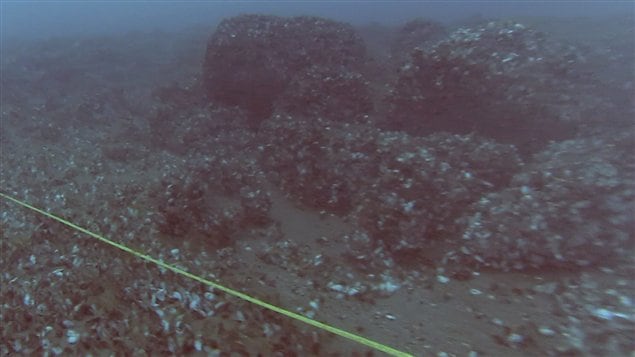REBROADCAST
ListenA long double stone wall used to corral caribou 9,000 years ago has been found by archeologists searching the bottom of Lake Huron in the heart of North America. The structure was built on what was a land ridge between two lakes and a natural migration path for vast herds of the ungulates.

Retreating glaciers exposed rich land
Paleo-Indians were moving onto land exposed by retreating glaciers and this area, which was about 100 metres below today’s water level, would have been a sub-arctic environment with trees and wetland, rich with wildlife.
“It was exciting to say the least,” says John O’Shea about the discovery. He is the project leader and an archeologist at the University of Michigan’s Museum of Anthropological Archaeology.
He and his team had been using sonar equipment, remotely-operated vehicles and their own diving skills to explore an area just over 50 kilometres from shore, about half way between Canada and the United States.

Small blinds found first
They had found several small blinds that individuals or small groups would have used in the fall to hunt caribou. But when researchers began to use new sonar with a 360-degree capability, one of the crew monitoring it from the boat got very excited.
“The graduate student who was operating the sonar, Ashley Lemke, suddenly said ‘Holy cow, look at this,’ and the whole image of this very elaborate drive lane with the two parallel lines, rock, and the hunting blinds all just appeared before our eyes,” said O’Shea.
Large spring gatherings indicated
This much larger, 30-metre lane ending in a dead end was oriented in the opposite direction from previous ones. O’Shea and his team surmised it was used in the spring and was designed for a large number of hunters who probably gathered there annually with their families.
The team would like to find evidence of an actual encampment to learn more about the people’s day-to-day lives at the time, but it will be more difficult because the remains will not be as large or as easily detected.

Underwater sites untouched
The advantage of looking for evidence underwater is that, unlike sites on land, they have not been bulldozed or built over. The disadvantages are having to work underwater, far from shore and in the highly variable conditions of this huge lake.
“Everyone has gotten very good at weather prediction,” says O’Shea. “It’s like working on the ocean…We don’t like it to be exciting. We like it to be boring. We like to have exciting finds, but we like the work to be pretty routine.”
Results of this research were published in Proceedings of the National Academy of Sciences.







For reasons beyond our control, and for an undetermined period of time, our comment section is now closed. However, our social networks remain open to your contributions.